#Portrait of a Lady with an Ermine by Leonardo da Vinci
Explore tagged Tumblr posts
Text
Photo © by Amber Maitrejean, of a display on the grounds of Clos Lucé, a château in Amboise, France.
Clos Lucé was the official residence of Leonardo da Vinci from 1516 until his death in 1519. Images of Leonardo's works printed on sheer panels seem to merge with the lush garden.
I believe the two shown here are details from (left) the Louvre's version of 'The Virgin of the Rocks,' and (right) 'Portrait of Cecilia Gallerani (Lady with an Ermine).'
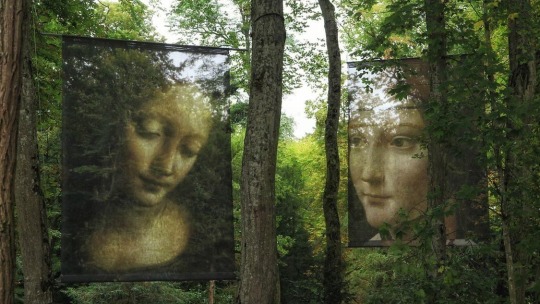
#Amber Maitrejean#photograph#Clos Lucé#château#france#Leonardo da Vinci#The Virgin of the Rocks#Portrait of Cecilia Gallerani#Lady with an Ermine#Artworks#art and soul
9 notes
·
View notes
Text
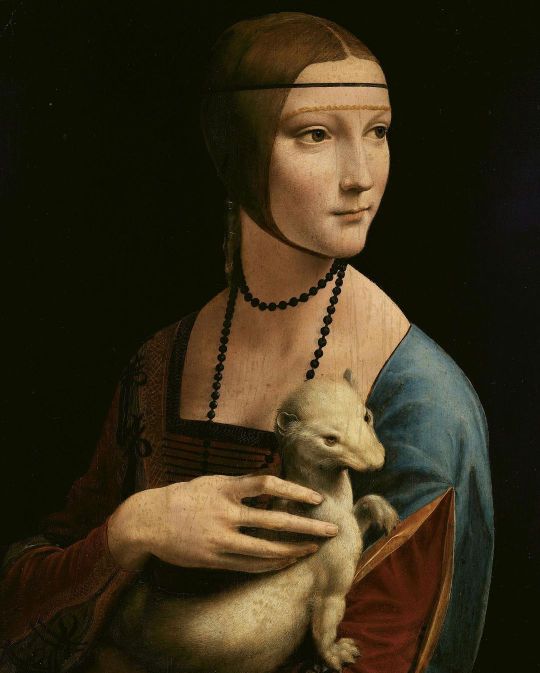
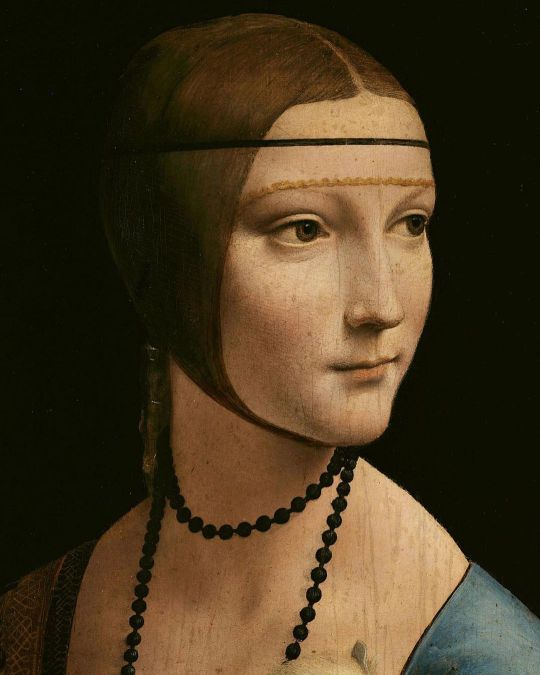
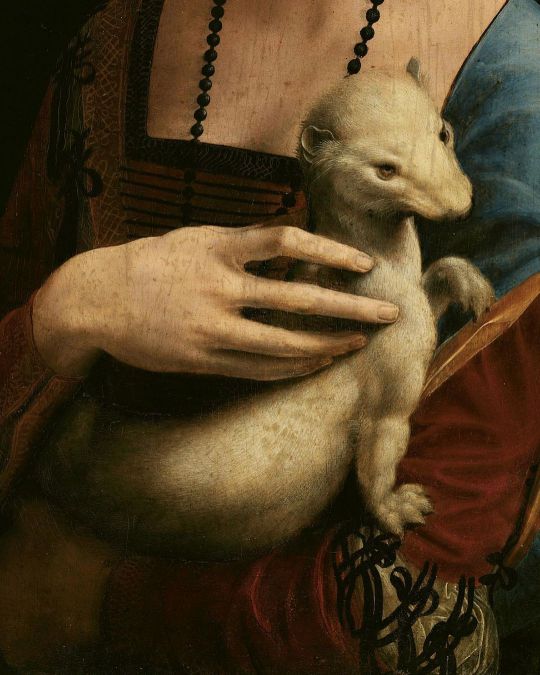
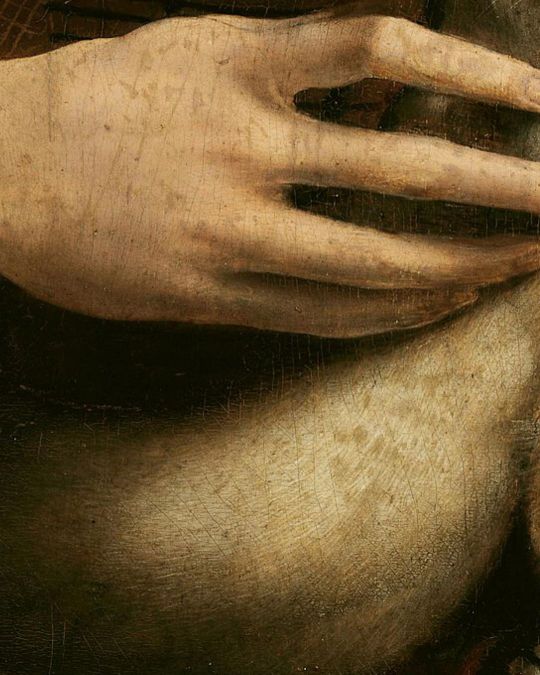
LADY WITH AN ERMINE /1490/ by LEONARDO DA VINCI
It is one of only four female portraits that Leonardo painted during his lifetime. The woman holding the ermine, or weasel, has been identified as Cecilia Gallerani, the mistress of the Duke of Milan, Ludovico Sforza, who Leonardo was working for at the time. She was just 16 years old at the time it was painted and was one of Leonardo’s closest female friends.
Different parts of this painting have been retouched over the years. The background has been darkened, which obscured a door that was originally present. Cecilia’s hair has been lengthened. The shadows between her fingers on her hand have been darkened. Her dress has been darkened as well.
Many aspects of this painting make it revolutionary and further support just how genius Leonardo was. First off, this oil painting was done in the very first years following the invention of oil as a medium. It appears that by this time, Leonardo had not only taken to the new art medium but had mastered it.
Second, Cecilia is depicted at a half turn, known as contrapposto, which was an art style actually invented by Leonardo. Prior to him, the sitters of portraits were usually depicted looking either straight on or in full profile.
Thirdly, the very soft and subtle shading (shading without borders) that can be seen on Cecelia’s neck and face, called sfumato, was a technique also invented by Leonardo. In fact, his fingerprints were found on the painting, suggesting that he used his fingers to blend the paint.
128 notes
·
View notes
Text

Portrait of Maria with Her White Cat By Jeff Stanford, 2023
Buy prints at: https://jeff-stanford.pixels.com/
Inspired by the painting “Lady with an Ermine” attributed to the Italian Renaissance artist Leonardo da Vinci as well as the photography by Irving Penn.
Irving Penn was born in 1917 in Plainfield, New Jersey. I was born there in 1955. He attended the Philadelphia Museum School of Industrial Arts from 1934–38. In 1964 the school became the Philadelphia College of Art, where I majored in Photography and film from 1977-81. It is now named University of the Arts.
#© Jeff Stanford#midjourney#midjourneyart#ai#discord#digitalart#aiart#Artists on tumblr#portrait#Maria#cat#white cat#Leonardo da Vinci#Irving Penn#Philadelphia College of Art#University of the Arts
203 notes
·
View notes
Text

“The Lady with an Ermine” (Portrait of Cecilia Gallerani) by Leonardo da Vinci, 1490
#leonardo da vinci#the lady with an ermine#15th century#art#painting#beauty#pure beauty#culture#dark academia aesthetic#italy#rome
20 notes
·
View notes
Text

The Lady with an Ermine” (Portrait of Cecilia Gallerani), 1490, by Leonardo Da Vinci (1452-1519).
19 notes
·
View notes
Text

Leonardo da Vinci (Italian, 1452-1519)
Lady with an Ermine, 1489-1490. Portrait of Chiara Galerani, mistress of the Duke of Milan
9 notes
·
View notes
Text
Lady with an Ermine
Leonardo da Vinci, 1489, Czartoryski Museum


A series of posts about pieces of art that I have used or that have inspired me to create my stories. What I will write about will deal with curiosities and interpretations regarding these works. The post is my private reflection and an encouragement to delve deeper into the topic, not a scientific treatise. This work was used in: Lady with an Ermine
The painting, painted in oil and tempera on wood, shows a portrait of Cecilia Gallerani, the young lover of Ludovico Sforza, for whom Leonardo was working at that time.
As for the appearance of the painting itself, Leonardo hesitated for a long time over its final version. At the beginning, Cecilia wasn't even holding an ermine, the background was not black, but dark blue.
It is believed that Cecilia did not hold any animal in her hands when she posed, the final version of the ermine is too large compared to the natural dimensions of this animal, so it is considered that the ermine has a symbolic meaning here.

There are several interpretations by historians of her presence. The first and most popular one refers to the fact that ermines are extremely clean animals that do not like to get their fur dirty, so it is considered an expression of the innocence and purity of Sfroza's lover.
The second one says that Ludovico Sforza used an ermine in his coat of arms, and its presence and her hand pressing the animal to her lower abdomen were to symbolize him and their son, who may have already been in her womb when Leonardo painted this painting.
From a young age he was engaged and married to a woman who strengthened his political position, but Cecilia caught his attention anyway and is believed to have become his lover when she was 16.
It is assumed that Ludovico was present himself when painting the portrait, he loved observing the sketches and Leonardo's work, for the same reason it is assumed that it is him that the model is looking at and that is why she has a bright, warm, soft and slightly pleased expression - you can see that the corner of her mouth is slightly raised.
Leonardo is a master of showing micro-expressions, as evidenced by the Mona Lisa, but in this painting he manages to capture a more innocent, delicate emotion.
The model's expression is filled with a pleasant calm - she seems happy with being painted and with her current position. She did not know then that Sforza's wife would quickly find her a husband - but this does not mean that Ludovico stopped visiting her.
In my story which refers to this painting, Aemond tells my heroine "to look to the side as if someone she had great sympathy for entered the room" - it refers to the belief that when Leonardo was painting her, she was looking at Ludovico.
17 notes
·
View notes
Text
between-the-tournaments minigame 1
have you submitted your favourite polish art pieces for the new tournament already? are you a little bored waiting for it to begin? GREAT NEWS there's a minigame for you (and there will be two more. maybe three)
i present: two paintings and two collections of paintings associated with poland but not by polish artists (one could argue in bacciarelli's case but shhh) - vote for the one you like best!




Lady with an Ermine by Leonardo da Vinci: one of the most valuable paintings exhibited in Poland, subject of a very rude comment by our (former) (stupid) minister of culture, also subject of many many arguments between Polish people whether the animal is an ermine or a weasel, a classic
Canaletto's paintings of Warsaw: detailed af, after the destruction of the city in World War 2 they were used as a reference during the rebuilding of the Old Town, simply iconic
Bacciarelli's portraits of his contemporaries as well as Polish historical figures: Bacciarelli spent over 50 years of his life in Warsaw and was a professor at the University and is considered one of the fathers of Polish national/historical art style, and his descendands lived in Poland, sooooo one could argue his art is Polish art and could feature in the main tournament, but idk. I guess if enough people submit him to the new tournament I will include him? but for now here he is
Beach in Pourville by Claude Monet: the only Monet painting in Poland afaik, mostly famous for its theft from the museum in Poznań in 2000 (found in 2010)
have fun! next minigame will be posted on saturday
36 notes
·
View notes
Text

Nueva página de mi cómic "Pintura y videojuegos". Espero que os guste la mezcla que he hecho. New page from my comic "Painting and video games". I hope you like the mix I've made.
"Self-portrait with monkeys" by Frida Kahlo, with some of the most famous monkeys from video games.
The cherubs from Raphael Sanzio's "Sistine Madonna", but they are Jocinero and Próximo, from Blasphemous.
"Lady with an Ermine" by Leonardo da Vinci, but instead of an ermine, it's the Pokémon Mienshao.
"Man eating beans" by Annibale Carracci, but the one eating is Kirby.
"Still life with skull" by Paul Cézanne, but with the skull from MediEvil.
"The desperate man" by Gustave Courbet, but it's Jinx, from League of Legends.
#digital art#digital#digital drawing#digitaldesign#digitalart#league of legends#jinx league of legends#frida kahlo#diddy kong#samba de amigo#mankey#pokemon#super monkey ball#mienshao#blasphemous#medievil#kirby#art
5 notes
·
View notes
Text

Self portrait master study of me and Tib in the style of Ramon Casas in the pose of Lady with an Ermine by Leonardo da Vinci with the colors often found in Claude Monets paintings.
Pieces sourced:
Female Figure in Red by Ramon Casas
Celebrations in Toulon by Ramon Casas
Lady with an Ermine by Leonardo da Vinci
Grainstacks in Bright Sunlight by Claude Monet
The Rio della Salute by Claude Monet
Falaises a Pourville, soleil levant by Claude Monet
5 notes
·
View notes
Text
Women with Weasels in Renaissance Art
Portrait of Cecilia Gallerani known as Lady with an Ermine by Leonardo da Vinci, 1489-91 and a close-up of the weasel. This proud, muscular little fellow seems just as important to the portrait as the lady. Lady with an Ermine The most famous weasel in Renaissance art is undoubtedly Leonardo da Vinci’s portrait of Lady with an Ermine. Why do I call this little white creature a weasel when the…
0 notes
Text

Leonardo da Vinci
Lady with ermine (1489 - 1490)
Cecilia Gallerani
The National Museum in Krakow
It is the second of only four surviving portraits of women painted by Leonardo, the others being Ginevra de' Benci, La Belle Ferronnière and the Mona Lisa.
1 note
·
View note
Text

Leonardo da Vinci The Lady with an Ermine, 1489
The Lady with an Ermine is a portrait painting widely attributed to the Italian Renaissance artist Leonardo da Vinci. Dated to c. 1489–1491, the work is painted in oils on a panel of walnut wood. Its subject is Cecilia Gallerani, a mistress of Ludovico Sforza ("Il Moro"), Duke of Milan; Leonardo was painter to the Sforza court in Milan at the time of its execution. It is the second of only four surviving portraits of women painted by Leonardo, the others being Ginevra de' Benci, La Belle Ferronnière and the Mona Lisa.
1 note
·
View note
Text
da Vinci exhibit shows artist's creative mastery

LOS ANGELES - Inventor. Artist. Dreamer. That’s how the California Science Center describes the Leonardo da Vinci exhibit hence the name of the exhibit. The exhibit opened to the public on March 2 and will be there until Sep. 2, 2024, when the exhibit will continue its tour nationally and internationally. The Leonardo da Vinci: Inventor. Artist. Dreamer exhibit was developed by Leonardo3 Museum of Milan, Italy, in collaboration with Running Subway Productions. Massimiliano Lisa is the co-curator of the Leonardo Da Vinci traveling exhibition. He is also the co-founder, CEO, and president of the Board of Directors of the Leonardo3 Museum.

“Everything you see here was done by our laboratory and by our research center,” said Lisa about the pieces of the exhibit. “So, every piece you see here has a history and this is the collection of what we have done in the last 20 years.” Da Vinci is known for his famous paintings, Mona Lisa, The Last Supper and Lady With an Ermine. However, da Vinci was more than a painter. This exhibit showcases who da Vinci really was. Besides his work and manuscripts, he also had life lessons you can learn and the motivation you can get from just looking at his work. “Leonardo wanted to experiment and to offer things nobody has ever done,” said Lisa. “And this is what we try to do with this exhibition in our museum." The moment you walk into the exhibit you see the creations of da Vinci, reproductions of his notes and artwork. In one particular room, you see some of his innovative machines each built by contemporary Italian artisans according to da Vinci’s exacting specifications. Futuristic flying machines are showcased In one of the rooms of the exhibit. The flying bicycle, Great Kite, and a 33-foot flying eagle are showcased in this room.

Dr. Diane Perlov, the senior vice president for special projects at the California Science Center favorite place is where all these innovative flying machines are showcased because you are able to see da Vinci’s evolution over the years. “I like to see the evolution of his thinking and that you can clearly see in the in the flight section,” said Perlov about her favorite part of the exhibition. “Leonardo studied flight for decades and in his notebooks you can really see how he learned things, he corrected things and he tried things,” said Perlov. “You see he did experiments, they didn't work, he did them again and again and again and you see that with the flight his thinking evolved.” Walking through the exhibit you also see some life lessons quotes like “He who thinks little makes a lot of mistakes.” So not only do you get to see da Vinci’s innovative work but you also get inspiration and life lessons. “We think it's a very inspirational exhibition. It doesn't focus so much on the genius of Leonardo, although you appreciate that clearly in the exhibition,” said Perlov. “But it focuses on something that has life lessons for our daily lives, which is the value of curiosity, of imagination. He experimented across disciplines.” The exhibit also premiered its latest innovation and Lisa’s favorite part of the exhibit. It is where guests are able to see digitally restored reproductions of some of da Vinci’s iconic artwork and discover details that have been lost in the original masterpiece. For each of the reproduced artwork, guests can learn more about each artwork and its restoration. “Is this wall with the paintings of Leonardo because it's the last one we've done,” said Lisa. “All these are using real sketches of Leonardo and all these you can see only here in our museum in Milan.”

“The art section is that he was innovative in how he painted portraits how he painted people,” said Perlov, about the paintings. “Da Vinci painted people that were caught in motion and he also painted emotion in their faces and that was a new thing of the time… his paintings were very influential.” When it comes to this exhibit the lessons you can learn from da Vinci’s work and his life story. “I think da Vinci would advise people to observe nature observe their world and also to experiment and fail and experiment again and fail and keep going,” said Perlov about the type of lessons da Vinci would give to someone who visited the exhibit. “He failed a lot but he always evolved and he learned from his things. He was a lifelong learner.” Lisa also expressed the same type of life lessons someone can take from enjoying this exhibition. “This is also a message we give with this exhibition, which is that you should not be afraid to continuously fail. Don’t be afraid to fail, to do things that other people do not do because by not following the path that others did before you,” said Lisa. “You can find something of your own, and when you express something of your own, other people usually like it and you can create something that makes the difference.” Read the full article
0 notes
Text
Exploring the Mastery of the Renaissance: Leonardo da Vinci Paintings at Merch Fuse
Welcome back to the Merch Fuse blog, where art enthusiasts connect with the masterpieces that have shaped our collective artistic heritage. Today, we delve into the realm of the Renaissance to appreciate the work of one of its brightest luminaries – Leonardo da Vinci.
Leonardo da Vinci Painting, a polymath and a pivotal figure of the High Renaissance, is acclaimed for his profound artistic and scientific contributions. His exquisite detail, masterful technique, and pioneering use of perspective make his paintings a timeless marvel.
At Merch Fuse, we're proud to provide access to a selection of Leonardo da Vinci's enduring works, allowing you to explore his genius and bring home a piece of the Renaissance.
One of the highlights of our collection is 'Mona Lisa', arguably the most famous painting in the world. Known for her enigmatic smile and Leonardo's groundbreaking technique of sfumato, 'Mona Lisa' remains a testament to Leonardo's unparalleled skill and innovation. Owning a reproduction of this masterpiece is like owning a piece of art history itself.
In addition to 'Mona Lisa', we also offer high-quality reproductions of 'The Vitruvian Man'. While not a painting, this iconic drawing represents Leonardo's meticulous study of human proportions and his continuous pursuit of harmonizing art and science. A copy of 'The Vitruvian Man' in your collection is a reminder of the endless human potential for knowledge and creativity.
'Lady with an Ermine', another one of Leonardo's celebrated paintings, is also available at Merch Fuse. This captivating portrait showcases Leonardo's skillful rendering of textures and his nuanced understanding of character and emotion. It's a splendid choice for anyone wishing to imbibe their surroundings with the grace and elegance of the Renaissance.
At Merch Fuse, we aim to provide more than just transactions. We endeavor to foster an enriching experience, offering historical insights, understanding the nuances of different art movements, and encouraging a deeper appreciation of the masterpieces that have shaped the world of art.
We invite you to dive into the world of Leonardo da Vinci with Merch Fuse. Explore his timeless masterpieces, enrich your collection, and let the beauty of the Renaissance breathe life into your everyday spaces.
0 notes
Note
Hello! First I wanted to make my most sincere compliments, your writings are something wonderful. Extremely detailed and touching, you can not read them without being at the mercy of strong emotions. I have often noticed in your works references to art, are you a "fan" (english is not my first language and i don't think this word to be appropriate, hope you understand) ? If yes, can you tell us about this? Maybe what works and artists you like or the themes you prefer, I often see references to Christian art in your work
Hi! This answer will be very long - first of all, thank you for your kind words about my writing, I want it to be like that. Secondly, yes, using art in my stories is not accidental, I finished my master's degree at the Faculty of Fine Arts, and my greatest inspiration since childhood is Leonardo da Vinci.
Copies of his Lady with an Ermine and the Mona Lisa hung in two rooms in the house where my grandmother once lived, and I stared at them all day long as a child, delighted by their mystery and enigmaticity. My dad was a fan of this painter himself and told me about him at my request, he had a Vitruvian Man T-shirt himself.
All my life I have strived for my works to have the same note of intimacy, mystery, incongruity and lightness as they do. I consider Lady with an Ermine (which, by a wonderful twist of fate, is located in my country, i.e. Poland, in Krakow) as one of the greatest portraits that has been painted in the world, and I saw it in person only when we went to Krakow together with my current husband, because previously the museum was undergoing renovation works.
I also painted my copy of this painting by the way:


Apart from him, I am a big fan of Michaelangelo, Bernini, de la Tour, Caravaggio, Tintoretto, van Gogh, Vermeer and many many other artists.
3 notes
·
View notes